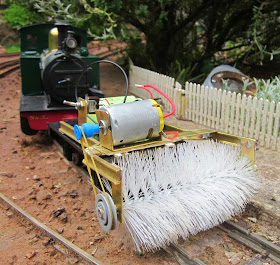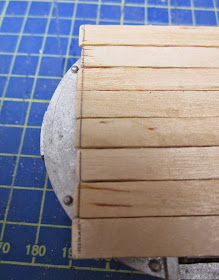Some interesting developments this month: for various reasons, not least a two week holiday in rural France, there has been little opportunity to have any proper operating sessions, but there has been plenty of activity in the workshop.
This year, I took the plan of a Davington Light Railway Manning Wardle 0-6-0 saddle tank locomotive with me and spent my time doing the basic groundwork of producing the body. Before leaving, I cut out the running plate and figured out how it would sit on the Piko motor block.
This then formed the basis for the next stage of the build. By the end of the holiday, I had made the cab and fixed this to the footplate as one unit.
I had also completed the boiler, tank, firebox and smokebox as a separate unit to simplify the painting process on my return to Blighty.
The next stage will be to add fine detailing to the bodywork and to construct the motion. I will also have to figure out where to locate the batteries and the radio control gear. The easiest solution would be to put everything in a trail car, but as I do a lot of shunting and run round trains at each terminus, I need to have each loco fully self contained. Despite its generous overall size, the saddle tank restricts the amount of usable internal space available. Locos with side tanks are far more obliging in the provision of workable space for radio controlled battery power (see How I constructed a Manning Wardle 0-6-0ST loco).
Fortunately, a fellow modeller had produced an impressive Picaxe program to realistically replicate the bouncing action of a signal (see Comparing two equations for signal control). The circuitry for wiring the outputs from the controller board to the servos was fairly straightforward and I linked the inputs to a very cost effective keyfob operated 4 channel receiver and transmitter.
As I have four signals at each station, this set-up will prove to be ideal for my needs. I still have to work out how I will power the receivers and servos at each station and organise the wiring for each signal. Also, I am uncertain as to the maximum length the servo leads can be to prevent significant loss of signal, but so far this seems to be a cost effective and effective means of controlling my signals.
Manning Wardle 0-6-0ST loco build
With full approval from my other half, I usually take some modelling materials with me to France and engage in some prime time modelling - literally on the kitchen table with the bare minimum of tools - a steel rule, a craft knife and a set of needle files.This year, I took the plan of a Davington Light Railway Manning Wardle 0-6-0 saddle tank locomotive with me and spent my time doing the basic groundwork of producing the body. Before leaving, I cut out the running plate and figured out how it would sit on the Piko motor block.
This then formed the basis for the next stage of the build. By the end of the holiday, I had made the cab and fixed this to the footplate as one unit.
I had also completed the boiler, tank, firebox and smokebox as a separate unit to simplify the painting process on my return to Blighty.
The next stage will be to add fine detailing to the bodywork and to construct the motion. I will also have to figure out where to locate the batteries and the radio control gear. The easiest solution would be to put everything in a trail car, but as I do a lot of shunting and run round trains at each terminus, I need to have each loco fully self contained. Despite its generous overall size, the saddle tank restricts the amount of usable internal space available. Locos with side tanks are far more obliging in the provision of workable space for radio controlled battery power (see How I constructed a Manning Wardle 0-6-0ST loco).
Remote control for signals
After my success with using a Picaxe controller circuit for the remote control of my LGB point motors (see Progress Report 52), I was keen to find a way of using servos to control my semaphore signals (see How I made 19 semaphore signals).Fortunately, a fellow modeller had produced an impressive Picaxe program to realistically replicate the bouncing action of a signal (see Comparing two equations for signal control). The circuitry for wiring the outputs from the controller board to the servos was fairly straightforward and I linked the inputs to a very cost effective keyfob operated 4 channel receiver and transmitter.
As I have four signals at each station, this set-up will prove to be ideal for my needs. I still have to work out how I will power the receivers and servos at each station and organise the wiring for each signal. Also, I am uncertain as to the maximum length the servo leads can be to prevent significant loss of signal, but so far this seems to be a cost effective and effective means of controlling my signals.


.jpg)
.jpg)
.jpg)















































